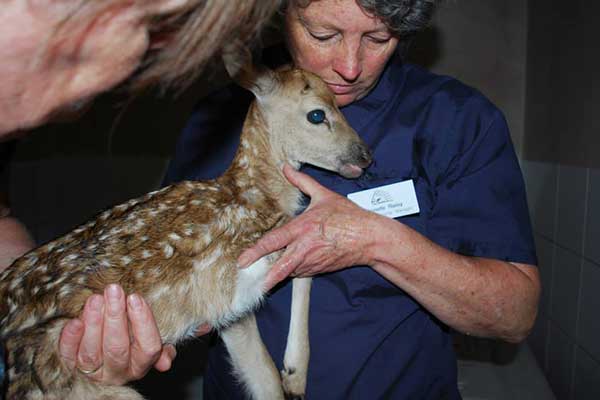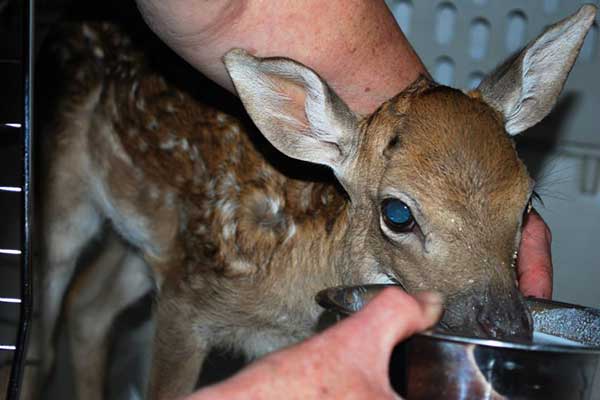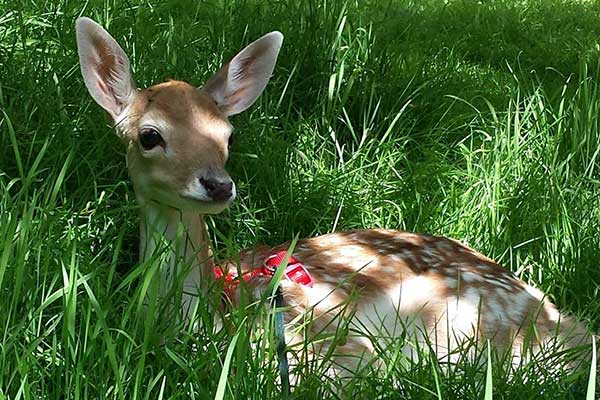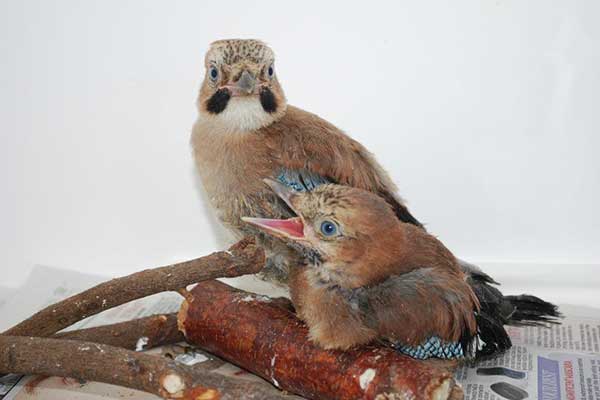Injured deer should not be moved or handled by members of the public as they can inflict serious injuries.
For out of our normal hours of operation please see After Hours Advice
Road Traffic Accidents
Road traffic accidents involving deer are extremely common in the region. During the autumn months, when the movement of deer at dawn and dusk to their feeding grounds coincides with the rush hour and when the rut or breeding season is in full swing, the Helpline receives at least one and sometimes two or three calls a day reporting accidents.
If you hit a deer or see an injured animal in or by the roadside, put your hazard lights on and if possible, position your vehicle so as to afford protection for the injured animal from on-coming traffic. Do not park too close to the animal. Deer are nervous and highly-strung. If you keep a reflective tabard in the car, put it on, as there is a very real danger from other road users who may not see you. If the animal is still alive DO NOT APPROACH IT.
Some authorities and even police forces advocate throwing a coat over the animal’s head to help calm it, but in our experience this very action can make the situation worse. Deer are powerful and dangerous animals which under normal circumstances will not tolerate the presence of humans. Antlers and hooves are formidable weapons and many people attempting to help have been badly injured by deer which have either suddenly sprung up or kicked them.
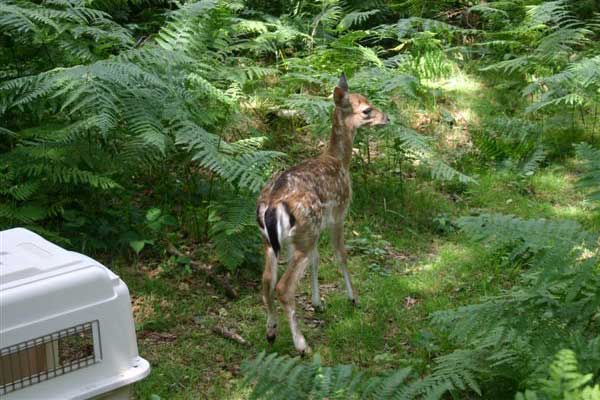
A fallow fawn being released a few hours after being hit by a car. We took it back to exactly where it had been picked up. The family group would have been nearby so he would soon meet up with them.
Your first action should be to call the Police. Deer in or beside the road are also a hazard to other road users and traffic control may be required. If the animal is mortally injured it is likely too that it will need to be humanely dispatched.
If you are unable to remain at the scene of the accident, please ensure a marker of some sort (a plastic carrier bag, scarf or similar) is left prominently and that the police or any other organisation that is going to attend is informed, as sometimes, especially if the animal if off the road, it can be difficult for searchers to find it.
Deer that remain recumbent at the roadside for more than 20 minutes have probably suffered injuries from which it is unlikely they will recover. In these cases, humane dispatch by a marksman using a licenced firearm is the best and kindest option.
Vets are unlikely to be able or willing to attend and in fact euthanasia at the roadside using barbiturate drugs is not a practical proposition, as the carcass would require immediate physical removed for cremation. Barbiturate poisoning would otherwise be a real possibility for any animal or human that consumed it.
Sometimes, an injured deer will get to its feet and make an escape into open country. This is probably the best outcome in the circumstances and no attempt should be made to restrain it. Many of these animals will go on to make a recovery.
Never attempt to put a deer in your car. We have had experience of this many times with people even transporting adult deer to us in this way. It is extremely dangerous, as a concussed deer may well come round while you are driving, and as deer, especially fallow, have suicidal instincts to avoid any contact with humans, the result could be devastating.
Fencing, Entanglement In Netting, Rope Etc...
Deer, especially young animals, are frequently caught by a rear leg in stock fencing or become entangled in electric fencing, games netting or discarded ropes and other rubbish.
Stock fencing is especially dangerous to deer. Very young animals, following their mothers and not able to jump it, will sometimes attempt to climb through it and become caught by the haunches, resulting in major soft tissue injuries. Some of these animals can be successfully treated, but due to the likelihood that any treatment will be extensive, re-establishing contact with their mothers is unlikely and provision has to be made for a long stay in captivity until they are independent.
Larger youngsters (and even adults), attempting to jump stock fencing will sometimes slip and become trapped in the two strands of wire that is frequently used to top this kind of fencing. The animal then falls to the ground, with its whole weight suspended on the extended leg. In its struggle to free itself, the animal’s hock will often be completely cut through to the bone, destroying the blood vessels, nerves and tendons.
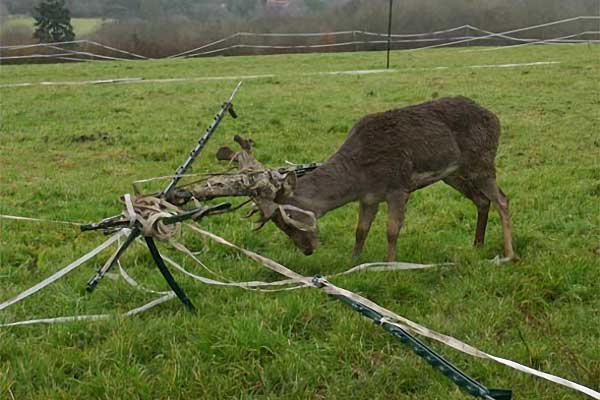
Fallow buck caught in electric fencing
The prognosis for these animals is very poor, as although three-legged deer do survive in the wild, the practical considerations of carrying out such a procedure (and it is not an option for male animals which must be able to fight and defend territory) are extremely doubtful.
Sports netting of the kind used for badminton, tennis, football and cricket practice, rope swings, discarded rope and wire and electric fencing is a major hazard for deer, especially males with antlers, which during the rut will often rub them against such items to mark their territory. This netting is often still secured to posts, making escape impossible.
Deer in these situations are extremely dangerous as they are often still free-running and should only be freed by experienced persons. Do not attempt to cut netting free if the animal is still entangled as it will only become caught again somewhere else.
If you come across a deer trapped in fencing or entangled in netting or rope, do not attempt to free it yourself.
Deer 'Trapped' In Gardens
Deer are more common in towns than is thought and will often come into gardens to eat roses and other plants.
We receive many calls regarding deer that are apparently trapped in gardens, having jumped fences which they then seem unable to jump back over. Usually, it is just that they have been discovered before they can leave, so the best option is to vacate the scene and leave them in peace, certainly until the following day, when invariably they are found to be gone.
It is very important that they are left alone and not approached. If your garden is small, pull the curtains at the rear of the house and keep children and dogs indoors. This may be inconvenient but is by far the best option. Attempts to capture deer in confined spaces such as these may even result in them jumping through windows in their efforts to escape and a deer driven from a garden in daylight may well be a hazard to drivers and pedestrians as it is likely to panic.
It can be helpful once it is dusk, to carefully open a back gate to help facilitate its escape. It is likely that the deer knows exactly where to go once night falls.
Deer Fawns
For the first few weeks after birth, deer fawns are left for much of the day on their own, in patches of undergrowth and long grass, with the mother only returning to feed them early in the morning and at night. She is also very likely to be close by.
If you come across a deer fawn in this situation, it is sometimes automatic to think that it has been orphaned or abandoned, but this is not likely to be the case. Retire immediately and do not handle it. If you have a dog with you, keep it on a lead and well away from the fawn.
If a fawn has been picked up (and even taken home) by a member of the public, all is not lost, as it is still possible to reunite a fawn with its mother up to 24 hours after being removed.
You can make a secure online donation via our CAF page.
Click on the button below and a new page will open with a variety of options with which to pay online.
Your kind and generous donation will directly help injured wildlife.

It is easy to set up a regular standing order by clicking the CAF image below. You will be taken to The Southern Wildlife Care and Advisory Trust's page on the CAF website where it will take just a few easy steps to set up a standing order by direct debit.

easyfundraising.org.uk is a great way to raise money for Folly Wildlife Rescue just by shopping online. You donít pay anything extra.
All you need to do is use click on the banner below to use our easyfundraising portal. Every time make a purchase from your favourite online retailers using the link below Folly Wildlife Rescue will receive a small payment, with no extra cost to you.

With the endless stream of wildlife casualties brought in to Folly Wildlife Rescue we are continually looking for stocks of essential items to aid recovery. With the introduction of our new nursery we will be able to cater for even more little babies, and with that comes more expense and that is where you, our supporters, may be able to help.
Our Amazon Wish List is updated frequently with all the essential items we needr. Your support is absolutely invaluable to us and every item purchased is a vital saving for our charity.

An adoption pack makes a great gift for a birthday or Christmas (or you can always treat yourself!) and is a very practical way to help hedgehogs in distress.
As well as illnesses and injuries the species is now seriously threatened by loss of habitat and housing developments, increased road traffic and unsympathetic farming practices




